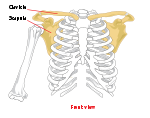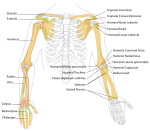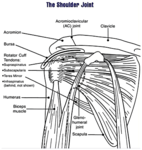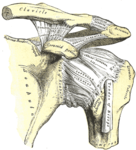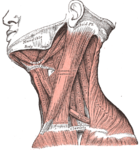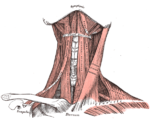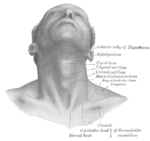- Clavicle
-
Bone: Clavicle Gray's subject #49 200 MeSH Clavicle In human anatomy, the clavicle or collar bone is a long bone of short length that serves as a strut between the scapula and the sternum. It is the only long bone in body that lies horizontally. It makes up part of the shoulder and the pectoral girdle and is palpable in all people, and, in people who have less fat in this region, the location of the bone is clearly visible as it creates a bulge in the skin.
It receives its name from the Latin: clavicula ("little key") because the bone rotates along its axis like a key when the shoulder is abducted, and it roughly the same shape as Roman door lock keys.
Contents
Human anatomy


Right clavicle — from below, and from above. 

Left clavicle — from above, and from below. The clavicle is a doubly curved short bone that connects the arm (upper limb) to the body (trunk), located directly above the first rib. It acts as a strut to keep the scapula in position so the arm can hang freely. Medially, it articulates with the manubrium of the sternum (breast-bone) at the sternoclavicular joint. At its lateral end it articulates with the acromion of the scapula (shoulder blade) at the acromioclavicular joint. It has a rounded medial end and a flattened lateral end.
From the roughly pyramidal sternal end, each clavicle curves laterally and anteriorly for roughly half its length. It then forms a smooth posterior curve to articulate with a process of the scapula (acromion). The flat, acromial end of the clavicle is broader than the sternal end. The acromial end has a rough inferior surface that bears prominent line, Trapezoid line and a small rounded projection, Conoid tubercle. These surface features are attachment sites for muscles and ligaments of the shoulder.
It can be divided into three parts. Medial end, lateral end and shaft.
Medial End
The medial end is quadrangular and articulates with clavicular notch of menubrium sterni to form sternoclavicular joint. Articular surface extends to inferior aspect for attachment with first costal cartilage.
It gives attachments to
1. Fibrous capsule of sternoclavicular joint all around
2. Articular disc superoposteriorly
3. Interclavicular ligament superiorlyLateral End
The lateral end is flat from above downward downward. It bears a facet for attachment to acromion process of scapula forming acromioclavicular joint. The area surrounding the joint gives attachment to joint capsule.
Shaft
The shaft is divided into medial 2/3 and lateral 1/3. Medial 2/3 is thicker than lateral 1/3.
Medial 2/3 of shaft
Medial 2/3 of shaft has 4 surfaces and no borders.
Anterior surface is convex forward and gives origin to pectoralis major. Posterior surface is smooth and gives origin to sternohyoid muscle at its medial end. Superior surface is rough at its medial part and gives origin to sternocleidomastoid muscle . Inferior surface has an oval impression at its medial end for costoclavicular ligament. At the lateral side of inferior surface, there is a subclavian groove for insertion of subclavius muscle. At the lateral side of subclavian groove, nutrient foramen lies.
Lateral 1/3 of shaft
It has 2 borders and 2 surfaces.
Anterior border is concave forward and gives origin to deltoid muscle. Posterior border is convex backward and gives attachment to trapezius muscle . Superior surface is subcutaneous. Inferior surface has a ridge called trapezoid line and a tubercle, the conoid tubercle for attachment with trapezoid and conoid part of coracoclavicular ligament that serves to connect the clavicle with the coracoid process of the scapula.
Attachments
Muscles and ligaments that attach to the clavicle include:
Attachment on clavicle Muscle/Ligament Other attachment Superior surface and anterior border Deltoid muscle deltoid tubercle, anteriorly on the lateral third Superior surface Trapezius muscle posteriorly on the lateral third Inferior surface Subclavius muscle subclavian groove Inferior surface Conoid ligament (the medial part of the coracoclavicular ligament) conoid tubercle Inferior surface Trapezoid ligament (the lateral part of the coracoclavicular ligament) trapezoid line Anterior border Pectoralis major muscle medial third (rounded border) Posterior border Sternocleidomastoid muscle (clavicular head) superiorly, on the medial third Posterior border Sternohyoid muscle inferiorly, on the medial third Posterior border Trapezius muscle lateral third The levator claviculae muscle, present in 2–3% of people, originates on the transverse processes of the upper cervical vertebrae and is inserted in the lateral half of the clavicle.
Functions
The clavicle serves several functions:[1]
- It serves as a rigid support from which the scapula and free limb (arm) are suspended; an arrangement that keeps the upper limb away from the thorax so that the arm has maximum range of movement. Acting as flexible, crane-like strut, it allows the scapula to move freely on the thoracic wall.
- Covering the cervicoaxillary canal, it protects the neurovascular bundle that supply the upper limb.
- Transmits physical impacts from the upper limb to the axial skeleton.
Development
The clavicle is the first bone to begin the process of ossification (laying down of minerals onto a preformed matrix) during development of the embryo, during the 5th and 6th weeks of gestation. However, it is one of the last bones to finish ossification, at about 21–25 years of age. It forms by intramembranous ossification. It consists of a mass of cancellous bone surrounded by a compact bone shell. The cancellous bone forms via two ossification centres, one medial and one lateral, which fuse later on. The compact forms as the layer of fascia covering the bone stimulates the ossification of adjacent tissue. The resulting compact bone is known as a periosteal collar.
Even though it is classified as a long bone, the clavicle has no medullary (bone marrow) cavity like other long bones ,though this is not always true . It is made up of spongy (trabecular) bone with a shell of compact bone.[1] It is a dermal bone derived from elements originally attached to the skull.
Variations
The shape of the clavicle varies more than most other long bones. It is occasionally pierced by a branch of the supraclavicular nerve. In manual workers it is thicker and more curved and the sites of muscular attachments are more pronounced. The right clavicle is usually stronger and shorter than the left clavicle.[1] In females the clavicle is thinner , smoother and lighter than that of males. Clavicle is a reliable criteria for sex determination
Common clavicle injuries
- Acromioclavicular dislocation ("AC Separation")
- Clavicle fractures
- Degeneration of the clavicle
- The collarbones are sometimes partly or completely absent in cleidocranial dysostosis
- Osteolysis
- Sternoclavicular dislocations
Evolutionary variation
The clavicle first appears as part of the skeleton in primitive bony fish, where it is associated with the pectoral fin; they also have a bone called the cleithrum. In such fish, the paired clavicles run behind and below the gills on each side, and are joined by a solid symphysis on the fish's underside. They are, however, absent in cartilagenous fish and in the vast majority of living bony fish, including all of the teleosts.[2]
The earliest tetrapods retained this arrangement, with the addition of a diamond-shaped interclavicle between the base of the clavicles, although this is not found in living amphibians. The cleithrum disappeared early in the evolution of reptiles, and is not found in any living amniotes, but the interclavicle is present in most modern reptiles, and also in monotremes. In modern forms, however, there are a number of variations from the primitive pattern. For example, crocodilians and salamanders lack clavicles altogether (although crocodilians do retain the interclavicle), while in turtles, they form part of the armoured plastron.[2]
In birds, the clavicles and interclavicle have fused to form a single Y-shaped bone, the furcula or "wishbone".
The interclavicle is absent in marsupials and placental mammals. In many mammals, the clavicles are also reduced, or even absent, to allow the scapula greater freedom of motion, which may be useful in fast-running animals.[2]
Though a number of fossil hominin (humans and chimpanzees) clavicles have been found, most of these are mere segments offering limited information on the form and function of the pectoral girdle. One exception is the clavice of AL 333x6/9 attributed to Australopithecus afarensis which has a well-preserved sternal end. One interpretation of this specimen, based on the orientation of its lateral end and the position of the deltoid attachment area, suggests that this clavicle is distinct from those found in extant apes (including humans), and thus that the shape of the human shoulder dates back to less than 3 to 4 million years ago. However, analyses of the clavicle in extant primates suggest that the low position of the scapula in humans is reflected mostly in the curvature of the medial portion of the clavicle rather than the lateral portion. This part of the bone is similar in A. afarensis and it is thus possible that this species had a high shoulder position similar to that in modern humans.[3]
Additional images
Pectoral girdle — frontHuman arm bones diagramDiagram of the human shoulder jointSternoclavicular articulation. Anterior view.The left shoulder and acromioclavicular joints, and the proper ligaments of the scapula.Muscles of the neck. Lateral view.Muscles of the neck. Anterior view.Anterolateral view of head and neck.Front view of neck.See also
- Bone terminology
- Terms for anatomical location
- Clavicle Research Survey
References
- ^ a b c Moore, Keith L.; Dalley, Arthur F. (1999). Clinically Oriented Anatomy (4th ed.). Lippincott Williams & Wilkins. ISBN 978-0683061413.
- ^ a b c Romer, Alfred Sherwood; Parsons, Thomas S. (1977). The Vertebrate Body. Philadelphia, PA: Holt-Saunders International. pp. 184–186. ISBN 0-03-910284-X.
- ^ Larson, Susan G. (2009). "Evolution of the Hominin Shoulder: Early Homo". In Grine, Frederick E.; Fleagle, John G.; Leakey, Richard E.. The First Humans - Origin and Early Evolution of the Genus Homo. Springer. p. 66. doi:10.1007/978-1-4020-9980-9. ISBN 978-1-4020-9979-3. http://www.springerlink.com/content/p22t46/#section=62942&page=1.
External links
Bones of upper limbs (TA A02.4, GA 2.200–230) Pectoral girdle,
clavicleScapula fossae (subscapular, supraspinatous, infraspinatous) · scapular notch · glenoid cavity
tubercles (infraglenoid, supraglenoid) · spine of scapula · acromion · coracoid process
borders (superior, lateral/axillary, medial/vertebral) · angles (superior, inferior, lateral)Humerus upper extremity: necks (anatomical, surgical) · tubercles (greater, lesser) · intertubercular sulcus
body: radial sulcus · deltoid tuberosity
lower extremity: capitulum · trochlea · epicondyles (lateral, medial) · supracondylar ridges (lateral, medial) · fossae (radial, coronoid, olecranon)Forearm Hand carpus: scaphoid · lunate · triquetral · pisiform · trapezium · trapezoid · capitate · hamate (hamulus)
metacarpus: 1st metacarpal · 2nd · 3rd · 4th · 5th
phalanges of the hand: proximal · intermediate · distalCategories:- Bones of the upper limb
- Skeletal system
- Upper limb anatomy
- Shoulder
Wikimedia Foundation. 2010.


